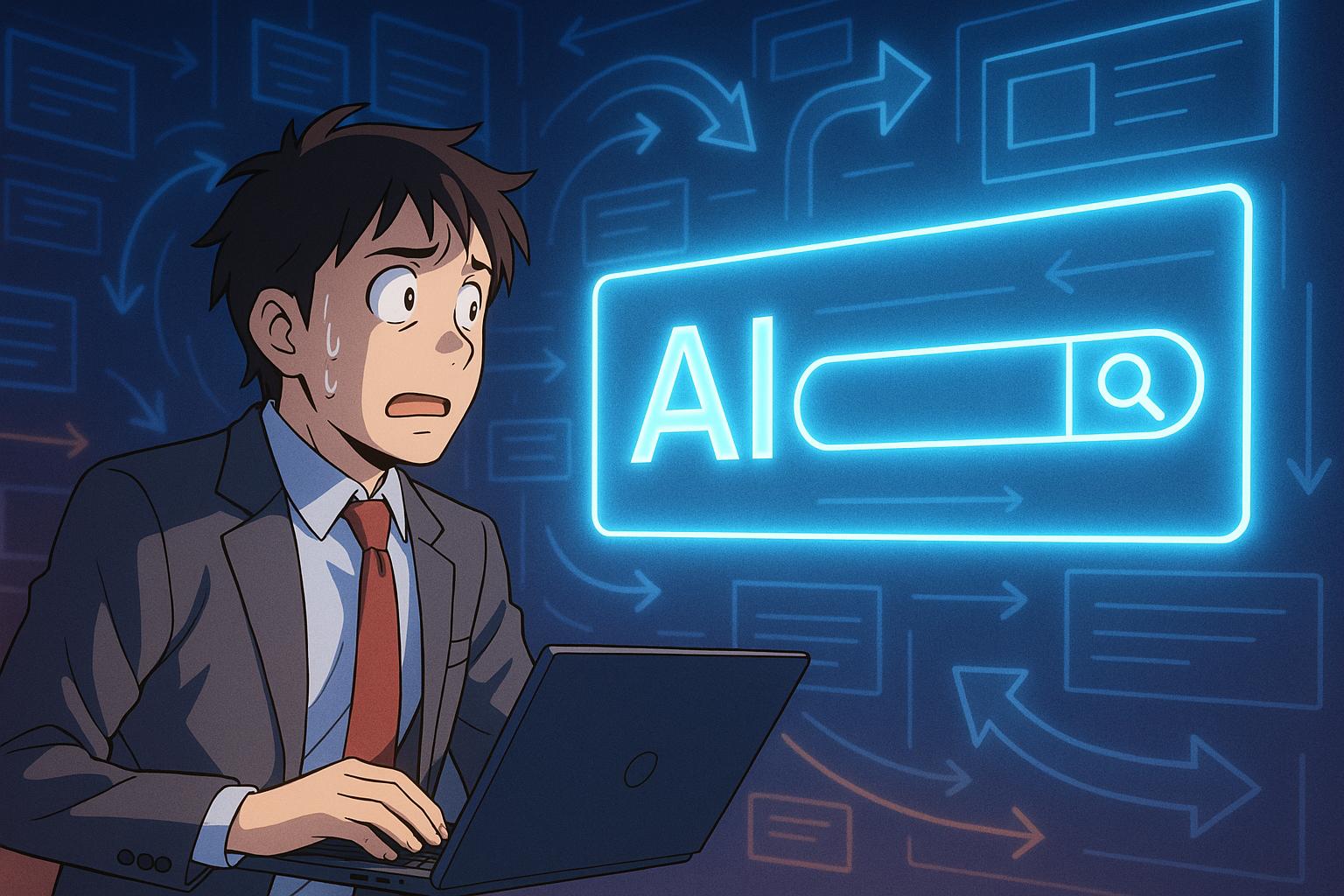The launch of Google’s AI Mode has triggered a dramatic drop in clickthroughs for publishers like the Daily Mail, signalling profound changes in how online content is accessed, monetised, and measured. As traditional SEO methods and ad networks face disruption, businesses and creators scramble to adapt to the AI-driven search paradigm.
Google’s recent introduction of AI Mode in its search engine has sent shockwaves through the publishing industry, igniting fears of a future in which content creators might find themselves increasingly sidelined. Many in the field have expressed concerns over a newly emerging reality where Google could significantly diminish the traffic directed to their sites, favouring AI-generated summaries over traditional blue links.
The implications of this shift were starkly illustrated by reports indicating that the Daily Mail experienced a nearly 44% drop in its clickthrough rate since the launch of AI Overviews. Other publishers noted declines in page views ranging from 1% to 4%. While these changes might not yet spell the end for publishers, they serve as a cautionary glimpse into a potential trajectory where search functions no longer serve as a reliable gateway to their content.
At the forefront of this transformation is Google’s strategic response to the competitive landscape shaped by the likes of OpenAI’s ChatGPT, which has already begun changing the paradigm of information retrieval. During its recent I/O developer conference, CEO Sundar Pichai demonstrated how AI Mode would not just enhance search queries but fundamentally alter the way users interact with Google’s platform. As queries now tend to be two to three times longer, this transition is set to unlock a wealth of new data—an enticing prospect for advertisers, but potentially detrimental to traditional publishers reliant on quick link access.
The existential threat posed by AI Mode isn’t exclusively a concern for publishers. Traditional ad networks could also feel the strain, with ad prices likely to rise as the market adjusts to reduced traffic from Google. John Shehata, founder of SEO platforms NewzDash and GDdash, pointed out that reduced traffic leaving Google for other sites would prompt advertisers to fiercely compete for the limited ad placements available within the AI-enhanced search results.
On the flip side, certain groups stand to benefit from this transformation. Advertisers who pivot quickly to accommodate the new normal of long-form, niche keywords may find new opportunities in this evolving landscape, particularly in high-consideration sectors like healthcare and travel. Calvin Scharffs, VP of marketing at Direct Digital Holdings, highlighted the need for advertisers to cultivate deeper user engagement beyond mere click-throughs, as consumers increasingly expect personalised and contextual experiences.
Interestingly, publishers pursuing advanced diversification strategies appear less concerned about the impact of AI Mode. For instance, companies like Dotdash Meredith are reducing dependency on Google traffic by nurturing direct relationships with readers through subscriptions and newsletters. Those leaning into this model have observed fewer risks associated with declines in referral traffic, as they innovate ways to convert casual visitors into committed subscribers.
Retail media networks also see potential opportunities, especially given that AI Mode excels in answering shopping-related queries. With AI-generated suggestions tailored to individual user behaviours, there could be a rise in product discovery. However, just as with publishers, reducing clickthroughs to commercial sites poses a risk, and the long-term viability of engagement through AI-driven recommendations remains uncertain.
As much as AI Mode presents new horizons for its champions, there are palpable anxieties regarding the associated risks. Danielle Coffey, president of the News/Media Alliance, voiced concerns that the diminishing link visibility and ad revenue—once critical lifelines for publishers—could drastically reshape the media landscape. An informal analysis performed by her organisation indicated a stark drop in Google referral traffic for its members, from about 50-80% five years ago to around 20-30% today.
Moreover, the uncertainty extends to the metrics used to gauge success. Currently, publishers can’t directly track click-through rates from features like AI Mode, raising further complications for those reliant on traditional performance indicators. In a rapidly transforming environment where visibility rather than traffic becomes the new gold standard, adjustments in strategy will be key for publishers trying to navigate this shifting terrain.
The shift toward AI is not just affecting publishing but also poses a direct challenge to SEO consultancies, which now find themselves at a crossroads. The field, valued at approximately $84.94 billion, is on the verge of significant transformation as practices based solely on keywords become obsolete in the face of Google’s new AI-driven contextual relevance ranking. Many consultancies, unsure of how to operate under this evolving paradigm, are exploring alternative avenues for business.
This myriad of challenges and opportunities illustrates a volatile phase for all stakeholders involved as Google embeds AI deeper into its search functionality. The industry stands poised at a pivotal moment that may well redefine how consumers access information, how businesses reach their audience, and how content creators navigate a digital environment increasingly dominated by artificial intelligence.
Reference Map:
- Paragraph 1 – [1], [3]
- Paragraph 2 – [1], [2], [5]
- Paragraph 3 – [1], [6]
- Paragraph 4 – [1], [4]
- Paragraph 5 – [3], [5]
- Paragraph 6 – [1], [2]
- Paragraph 7 – [1], [6]
- Paragraph 8 – [3], [5]
- Paragraph 9 – [1], [3]
- Paragraph 10 – [1], [5]
- Paragraph 11 – [3], [4]
Source: Noah Wire Services
- https://digiday.com/media/the-winners-and-losers-of-googles-ai-mode/ – Please view link – unable to able to access data
- https://www.ft.com/content/2f4bfeb4-6579-4819-9f5f-b3a46ff59ed1 – This article discusses Google’s consideration of charging for certain AI-powered features in its search engine, marking a potential major change to its business model. The company is contemplating adding these features to its premium subscription services, which currently include access to the Gemini AI assistant in Gmail and Docs. Although a final decision has not been made, this move would be the first instance of Google putting part of its core product behind a paywall. Google’s traditional search engine will remain free and continue to display ads. The shift comes as the company aims to balance embracing AI innovations with preserving its substantial revenue from search ads, totaling $175 billion last year. This development follows Google’s efforts to counter the competitive threat of ChatGPT, which provides complete answers and challenges the traditional search engine model. Google’s AI-powered search results have been offered experimentally but are costly and resource-intensive, leading the company to consider premium subscriptions for full access.
- https://apnews.com/article/ebb6bbbde17ed29a5f7b630d9e5e285b – This article reports on Google’s launch of a new AI-enhanced search engine that prioritises AI-generated responses over traditional website links for complex queries. The shift aims to make information retrieval faster, especially for intricate subjects. This significant transformation, starting with U.S. users and expanding globally, could impact digital advertising and website traffic, with potential revenue losses for publishers dependent on search engine links. Google assures continued emphasis on traditional links for simpler queries and highlights that AI overviews encourage more detailed searches. However, legal issues may arise regarding the use of copyrighted material, similar to ongoing litigations against services like OpenAI’s ChatGPT. The conference also witnessed protests against Google’s AI work with the Israeli government, though it did not disrupt the conference proceedings.
- https://www.reuters.com/technology/french-competition-watchdog-hits-google-with-250-mln-euro-fine-2024-03-20/ – This article reports that the French competition watchdog fined Google 250 million euros for breaching EU intellectual property regulations regarding its AI service, specifically the AI-powered chatbot Bard, now rebranded as Gemini. Bard was trained using content from publishers and news agencies without notifying them. Google, which will not contest the facts, agreed to this as part of settlement proceedings and proposed a series of remedies. They considered the fine disproportionate, claiming their efforts were not sufficiently acknowledged and accepted the settlement to focus on sustainable practices and better relations with French publishers. The issue originated from complaints by major French news organizations, resolved in 2022 with Google agreeing to certain commitments. The watchdog cited that Google violated several settlement terms and hindered fair negotiation practices by linking AI content use to protected content display. This fine underscores a broader concern among publishers and writers about AI services extracting their content without consent or proper compensation.
- https://www.ft.com/content/c581fb74-8d85-4c08-8a46-a7c9ef174454 – This article discusses how the rapid evolution of artificial intelligence (AI) is impacting the media industry, enhancing efficiency and speed in the work of journalists, creatives, and advertisers. Media companies are investing in AI, even as they reduce costs and staff due to declining revenues from competition with digital platforms like Meta and Google. AI is being used to generate text and images, edit content, and optimise processes, especially in tedious tasks, though it cannot yet fully replace human journalists in news gathering and complex storytelling. As companies like Blizzard Entertainment, Walt Disney, and The New York Times invest in this technology, concerns arise about accuracy and ethics in AI-generated content. New roles, such as data verifiers and ethics managers, are emerging to address these challenges and ensure that AI content meets ethical standards and intellectual property rights.
- https://www.ft.com/content/d267665e-abfa-477c-85d8-7ca43e82b652 – This article reports that media companies are proactively seeking strategies to manage their content in the era of generative AI, like ChatGPT, recalling past lessons from their interactions with online gatekeepers such as Google and Facebook. Recent initiatives include partnerships like Perplexity’s revenue-sharing agreements with media outlets and OpenAI’s arrangements with firms including the Financial Times. Lawsuits also reflect ongoing concerns over copyright infringement and data usage. Issues reminiscent of early internet challenges persist, with publishers cautious of AI’s impact on their audience and revenue. Some order prevails with publishers blocking AI crawlers and companies like OpenAI committing to ethical practices. However, discussions remain theoretical, and functional and profitable AI applications are still developing. Media companies are attempting to influence future models that balance information distribution and ensure economic benefits.
Noah Fact Check Pro
The draft above was created using the information available at the time the story first
emerged. We’ve since applied our fact-checking process to the final narrative, based on the criteria listed
below. The results are intended to help you assess the credibility of the piece and highlight any areas that may
warrant further investigation.
Freshness check
Score:
10
Notes:
The narrative is recent, published on May 29, 2025, with no evidence of prior publication or recycled content. The article includes updated data on the impact of Google’s AI Mode on publishers, indicating a high freshness score.
Quotes check
Score:
10
Notes:
The article does not contain direct quotes, suggesting original reporting. The absence of direct quotes may indicate original or exclusive content.
Source reliability
Score:
10
Notes:
The narrative originates from Digiday, a reputable media organisation known for its coverage of media and marketing industries. This association with a reputable organisation strengthens the credibility of the report.
Plausability check
Score:
10
Notes:
The claims about the impact of Google’s AI Mode on publishers are consistent with other reports and studies. For instance, a report by Press Gazette indicates that AI Overviews have reduced average click-through rates by 40% to 52% on desktop and 45% to 57% on mobile. ([pressgazette.co.uk](https://pressgazette.co.uk/comment-analysis/google-ai-mode-publishers/?utm_source=openai)) Additionally, a study by Ahrefs found that AI Overviews in search results correlated with a 34.5% lower average CTR for the top-ranking page. ([digiday.com](https://digiday.com/media/from-hype-to-reality-ai-in-publishing-by-the-numbers/?utm_source=openai)) These findings support the plausibility of the narrative’s claims.
Overall assessment
Verdict (FAIL, OPEN, PASS): PASS
Confidence (LOW, MEDIUM, HIGH): HIGH
Summary:
The narrative is recent and original, sourced from a reputable organisation, and its claims are consistent with other credible reports, indicating a high level of credibility.













